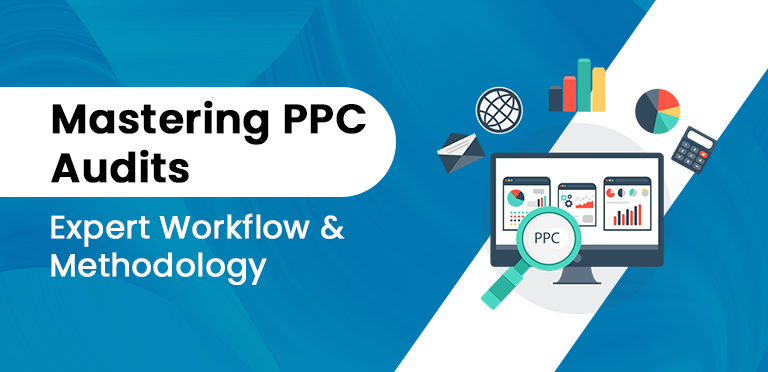Mastering PPC Audits: Expert Workflow & Methodology



Running Pay-Per-Click (PPC) campaigns without regular audits is like driving with your eyes closed – risky and potentially costly. A PPC audit serves as your campaign’s health check, revealing hidden opportunities and preventing wasteful spending.
Think of a PPC audit program as your campaign’s GPS system. It guides you through the complex landscape of digital advertising, helping you navigate toward better ROI and improved performance. This systematic evaluation process examines every aspect of your campaigns, from tracking accuracy to competitor analysis.
The real power lies in mastering the competitive paid search audit methodology. When you understand the intricate details of the audit process, you can:
- Identify underperforming keywords and eliminate wasted spend
- Uncover new opportunities for growth and expansion
- Optimize bidding strategies for maximum returns
- Strengthen your targeting to reach the right target audience
- Fix technical issues before they impact performance
In this PPC guide for auditing, we’ll walk you through the steps to evaluate your campaigns effectively.
Understanding the PPC Audit Process
PPC stands for Pay-Per-Click and a PPC audit is a careful look at your paid advertisements to find what’s working, what’s not, and where you can improve. It’s like a check-up for your ads, helping you fix problems and make them perform better.
The primary purpose of conducting a PPC audit is to ensure your advertising budget delivers maximum value. This systematic review process helps you:
- Identify Wasteful Spending: Spot areas where your budget might be leaking through inefficient targeting or poor keyword selection
- Uncover Hidden Opportunities: Find potential growth areas that might have been overlooked in day-to-day campaign management
- Optimize Campaign Structure: Assess if your campaigns are organized for maximum effectiveness
- Improve Quality Scores: Evaluate factors affecting your ad relevance and landing page experience
Key objectives when conducting a PPC audit include:
- Performance Assessment: Analyzing key metrics like click-through rates, conversion rates, and cost per acquisition
- Budget Optimization: Ensuring efficient allocation of resources across campaigns
- Competitive Analysis: Understanding your position in the market compared to competitors
- Strategic Alignment: Confirming that PPC efforts align with broader marketing goals
- Technical Health: Checking for proper tracking implementation and data accuracy
A good PPC audit guide helps you in improving your ads, making smart choices based on data to get a better return on investment. It shows you where to improve things like targeting, bids, and ad designs for better results.
Step-by-Step Workflow for Conducting a PPC Audit
Here are the essential steps of a comprehensive Pay-Per-Click audit that will help you uncover hidden opportunities and optimize your campaigns.
1. Tracking Accuracy Verification
Your PPC success depends on reliable data. Start by checking your conversion tracking setup in Google Analytics and your ad platform. Common tracking issues include:
- Missing tracking codes on landing pages
- Duplicate conversion counting
- Broken thank-you page redirects
- Incorrect goal setup in Google Analytics
Use Google Tag Assistant to verify proper implementation and cross-reference conversion data between platforms to spot discrepancies.
2. Account Structure Assessment
A well-organized account structure forms the foundation of successful PPC campaigns. Review your account architecture with these key elements:
- Campaign Segmentation: Separate campaigns by product lines, services, or geographic locations
- Ad Group Organization: Group closely related keywords (8-20 per ad group)
- Budget Distribution: Allocate spending based on performance data
- Settings Review: Check location targeting, language settings, and network distribution
3. Audience Integration
Your audience data holds valuable insights for campaign optimization. Analyze your Google Analytics data to:
- Create custom audience segments based on user behavior
- Identify high-value customer patterns
- Adjust bid modifiers for different demographic groups
- Implement remarketing lists for search ads (RLSA)
4. Keyword Performance Analysis
Examine your keyword strategy to ensure alignment with user intent:
- Search Term Analysis: Review search query reports to identify new keyword opportunities
- Match Type Distribution: Balance broad, phrase, and exact match types
- Quality Score Optimization: Focus on improving low-performing keywords
- Intent Mapping: Match keywords to specific stages of the buyer’s journey
Consider using tools like Google Ads Keyword Planner to uncover new keyword opportunities and assess competition levels. Regular search term analysis helps refine your keyword strategy and eliminate wasteful spending.
Enhancing Campaign Performance Through Device/Channel Evaluation and Strategic Bidding
A detailed analysis of device and channel performance can provide valuable insights that significantly improve your PPC campaign results. In this article, we’ll discuss how to effectively evaluate these crucial elements of your campaign.
Device Performance Analysis
Your PPC campaigns target users on different devices such as desktop computers, tablets, and mobile phones. Each device type has its own unique user behaviors and conversion patterns. Here are the key areas to focus on when analyzing device performance:
1. Review Device-Specific Metrics
Look into the following metrics to gain a better understanding of how each device is performing:
- Cost per conversion by device
- Click-through rates across platforms
- Conversion rates per device type
- Average position variations
2. Understand Usage Patterns
Examine the usage patterns associated with each device to uncover potential opportunities for optimization:
- Identify peak performance hours by device
- Analyze geographic performance differences
- Assess user engagement levels
Channel Performance Evaluation
Different advertising channels play distinct roles in your marketing funnel. To evaluate channel performance effectively, consider the following steps:
1. Analyze Cross-Channel Performance Metrics
Compare the performance of different channels using these key metrics:
- Return on ad spend (ROAS) by channel
- Cost per acquisition comparisons
- Impression share analysis
- Quality score variations
2. Identify Channel-Specific Optimization Opportunities
Look for specific areas within each channel where you can make improvements:
- Optimize search network settings based on performance data
- Refine display campaign targeting strategies
- Enhance shopping campaign product feed quality
- Evaluate video advertising creative effectiveness
Strategic Bidding Review
Your bidding strategy has a direct impact on both campaign performance and budget efficiency. Take the time to review these important aspects of your bidding approach:
1. Assess Bid Strategy Effectiveness
Determine how well your current bid strategies are working by analyzing:
- Manual vs. automated bidding performance
- Target CPA effectiveness
- Enhanced CPC results
- Maximum CPC adjustments
2. Evaluate Bid Modifiers Impact
Understand how different bid modifiers are influencing your campaign results:
- Location-based adjustments: Are certain locations driving more conversions?
- Device-specific modifications: Are you seeing better performance on specific devices?
- Time-of-day performance: Do certain times of day yield higher click-through rates or conversions?
- Audience segment variations: Are specific audience segments responding better to your ads?
Once you know which platforms are doing well, adjust your bids to match your campaign goals. This might mean increasing bids for devices or channels that are working, and spending less on those that aren’t performing as expected.
It’s important to keep in mind seasonal trends and market conditions when making these bid adjustments. A successful bidding strategy strikes a balance between pursuing aggressive growth opportunities and maintaining control over spending in order to maximize return on investment (ROI) for your campaigns.
Optimizing Ad Content, Competitor Insights, and Continuous Auditing for Sustained Success
Your ad copy is how you talk to potential customers. Looking closely at your ad content helps you understand what works best. Start by checking your click-through rates (CTR) for different ads. The best ads usually have a few things in common: they address what users need, have clear calls-to-action, and match what people are searching for.
Reviewing Ad Extensions
- Implement all relevant extension types (sitelinks, callouts, structured snippets)
- Test different extension combinations to maximize ad real estate
- Remove underperforming extensions that don’t contribute to conversion goals
Your competitors’ campaigns can teach you valuable lessons about market positioning and user preferences. Use competitive research tools to analyze:
- Google Ad campaign themes and messaging approaches
- Unique selling propositions
- Landing page experiences
- Keyword targeting strategies
This research helps identify gaps in your own campaigns and opportunities to differentiate your offerings.
Creating a Regular Audit Schedule
A structured approach to ongoing PPC campaign audits helps maintain campaign health:
Weekly Checks:
- Budget pacing
- Conversion tracking
- Key performance metrics
Monthly Reviews:
- Ad copy performance
- Audience behavior patterns
- Quality Score improvements
Quarterly Deep Dives:
- Historical trend analysis
- Seasonal performance planning
- Strategic positioning updates
Consider setting up automated alerts for significant performance changes. These alerts help you spot issues quickly and make necessary adjustments before they impact your campaign results. Document performance patterns you discover during each audit – they often reveal cyclical trends you can leverage for future campaign optimization.
Remember to cross-reference your findings with your initial campaign goals. This practice helps ensure your optimization efforts align with your broader marketing objectives and business targets.
Documenting Findings and Making Actionable Recommendations for Future Audits
Documentation practices serve as your PPC campaign’s historical record and roadmap for future optimization. Let’s explore how to create meaningful documentation that drives results.
Creating Detailed Audit Records
- Use standardized PPC audit templates to maintain consistency across all audit sessions
- Include screenshots of key metrics and settings
- Document the date, time, and specific account areas reviewed
- Note any unusual patterns or anomalies discovered
- Record specific changes made during the audit
Building Action-Oriented Recommendations
Your audit findings should translate into clear, implementable steps. Structure your recommendations like this:
- Priority Level: Label each finding as high, medium, or low priority
- Current Status: Document the existing situation with specific metrics
- Target Goal: Define measurable objectives
- Action Steps: Break down the implementation process
- Timeline: Set realistic deadlines for each action item
- Resource Requirements: List needed tools, budget, or personnel
Sample Documentation Format:
Finding: High CTR but low conversion rate in Campaign A Priority: High Current Status: 5% CTR, 1% conversion rate Target Goal: Increase conversion rate to 3% Action Steps:
- Review landing page content alignment
- A/B test call-to-action buttons
- Implement exit-intent surveys Timeline: Complete within 2 weeks Resources: Landing page developer, A/B testing tool
Remember to store your documentation in a centralized location accessible to all stakeholders. This ensures seamless knowledge transfer and consistent implementation of improvements across your PPC campaigns.
Conclusion
A well-executed PPC checklist can transform your advertising audits for campaigns from good to exceptional. The PPC audit methodologies outlined in this guide serve as your roadmap to improve PPC campaign performance through systematic evaluation and optimization.
These PPC audit tips aren’t just ideas – they’re real strategies used by top marketers to get great results. By following this PPC Audit checklist in 2025, you’ll better understand what’s working and what’s not in your campaigns, helping you make smart choices to get the most out of your ad budget.
Ready to take your PPC campaigns to the next level? The team at Phoenix Ninja specializes in advanced PPC optimization strategies. We’ve helped countless businesses unlock their campaigns’ full potential through our expert PPC audit services. Visit our website to discover how we can help you implement these strategies and achieve breakthrough results in your PPC campaigns.
Remember: A thorough PPC audit isn’t a one-time task – it’s an ongoing commitment to excellence that yields compounding benefits over time. Each audit cycle brings new opportunities for optimization and growth.
Frequently Asked Questions (FAQs)
We recommend conducting comprehensive PPC audits quarterly, with mini-audits monthly to catch any immediate issues.
Google Ads Editor, Google Analytics, and conversion tracking tools are must-haves. Third-party tools like SEMrush or Ahrefs can provide additional insights.
Yes, you can perform basic audits yourself using our methodology. Complex accounts might benefit from professional expertise.
Incorrect conversion tracking setup and inefficient keyword targeting are frequent findings that impact campaign performance.
A comprehensive audit typically takes 2-5 days, depending on account size and complexity.